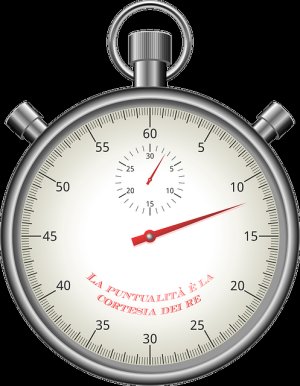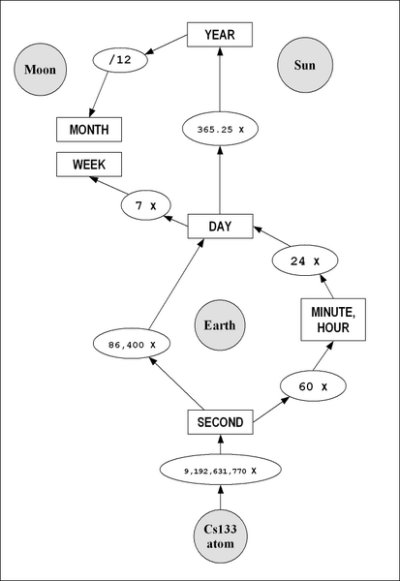Units of Measurement

The measurement of time requires the specification of units, but there are many different units of time, some of which may be more appropriate in certain circumstances than others.
SI Units
The International System of Units (Système Internationale d’Unités or SI) defines seven base units of measurement from which all other SI units are derived. The base unit for time is the second (the other SI units are: metre for length, kilogram for mass, ampere for electric current, kelvin for temperature, candela for luminous intensity, and mole for the amount of substance). The second can be abbreviated as s or sec.
Historically, a second was defined by reference to longer periods of time – minutes, hours and days – e.g. as 1/86,400 of a mean solar day (one day being 24 hours x 60 minutes x 60 seconds = 86,400 seconds). This is sometimes known as an ephemeris second (an ephemeris is a table showing the positions of the heavenly bodies on various dates in a regular sequence).
Since the establishment of the SI system in 1967, a second is technically defined in more precise and absolute atomic terms as “the duration of 9,192,631,770 periods of the radiation corresponding to the transition between the two hyperfine levels of the ground state of the caesium 133 atom”. In 1997, this definition was made even more specific with the stipulation that this refers to a caesium atom at rest at a temperature of 0° Kelvin.
Given that the Earth is very gradually slowing, and the mean solar day on which the original definition of a second was based has not remained the same, its definition is arguably a historical and cultural choice, even an arbitrary one. But at least the atomic definition we now use, whatever its provenance, will always remain constant. All other units of time measurement are now derived from the second. In fact, because we can measure time more accurately than length, even the SI measurement of the metre is defined in terms of the distance travelled by light in 0.000000003335640952 seconds.
Multiples and Submultiples
Units for periods of time shorter or longer than a second can be derived by applying the standard metric SI prefixes to the second:
|
↑ |
second |
↓ |
|
| decisecond = 1/10 secondcentisecond = 1/100 secondmillisecond = 1/1,000 secondmicrosecond = 1/1,000,000 second
nanosecond = 10-9 second picosecond = 10-12 second femtosecond = 10-15 second attosecond = 10-18 second zeptosecond = 10-21 second yoctosecond = 10-24 second |
decasecond = 10 secondshectosecond = 100 secondskilosecond = 1,000 seconds (about 16.7 minutes)megasecond = 1,000,000 seconds (about 11.6 days)
gigasecond = 109 seconds (about 31.7 years) terasecond = 1012 seconds (about 31,700 years) petasecond = 115 seconds (about 31.7 million years) exasecond = 1018 seconds (about 31.7 billion years) zettasecond = 1021 seconds (about 31.7 trillion years) yottasecond = 1024 seconds (about 31.7 quadrillion years) |
||
Time Unit Measurements
Weeks until the end of the year
Counting time from before today
Other Units

More commonly, outside of purely scientific usage, other units are used for longer periods of time. Although technically “non-SI” units, because they do not use the decimal system, these units are officially accepted for use with the International System.
- minute (60 seconds)
- hour (60 minutes, or 3,600 seconds)
- day (24 hours, or 86,400 seconds)
- week (7 days, or 604,800 seconds)
- month (28-31 days, or 2,419,200-2,678.400 seconds)
- year (about 365.25 days, or about 31,557,600 seconds)
For even longer periods, some multiples of years are commonly used, e.g. decade (10 years), century (100 years), millennium (1,000 years), mega-anuum (1,000,000 years), etc.
In everyday speech, some less exact units of time are also commonly used, e.g. instant, moment, shake, jiffy, season, age, epoch, era, eon, etc. Some of these terms also have specific meanings in certain circumstances (e.g. in periodization), but in general usage their length is indefinite or ambiguous.
Quantum of Time
The chronon is a unit for a proposed discrete and indivisible unit of time in theoretical physics, known as a quantum of time. Such a unit may be used as part of a theory that proposes that time is not continuous but composed of many discrete units. It should be stressed that, according to our current understanding of physics, in both quantum mechanics and general relativity (which together make up most of modern physics), time does NOT come in quantized, discrete packages, but is smooth and continuous – see the section on Quantum Time. A discrete model may however be useful for some more obscure and largely hypothetical theories that try to combine quantum mechanics and relativity into a theory of quantum gravity.
It is not even clear what the value of a chronon might be. One candidate for it is Planck time (an infinitesimal 5.39 x 10-44 seconds), which is the time required for light to travel in a vacuum a distance of 1 Planck length, and is regarded by most physicists as the smallest time measurement possible, even in principle. Although much too small to have many practical applications, Planck time is consistent with the other Planck units for length, temperature, mass, density, etc, which are sometimes used in theoretical physics. Another possible candidate for the chronon is the time needed for light to travel the classical radius of an electron.